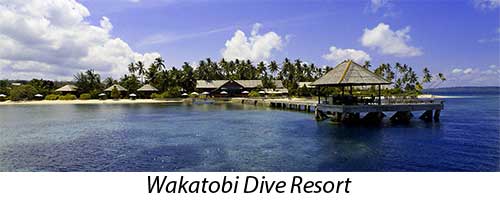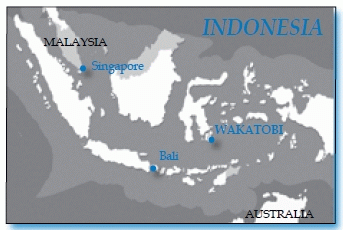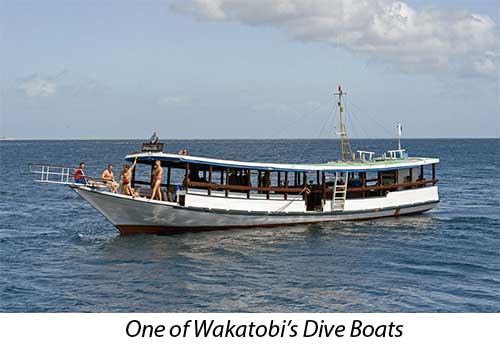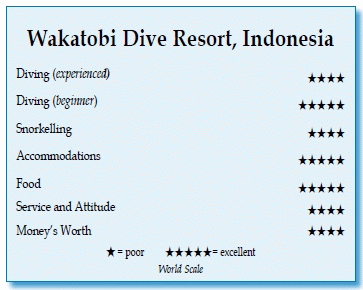Wakatobi Dive Resort, IndonesiaContents of this Issue: Rocio del Mar, Sea of Cortés, Mexico Scubapro Recalls Some Aladin Square Computers Wakatobi Dive Resort, Indonesia What Schwarzenegger Movie Title Fits the Lionfish Best? What to Do with Camera Batteries on Flights New Life-Saving Gear for Freedivers Does Diving Affect Your Hearing? Father and Son Divers Sue the Boat that Hit Them Editorial Office: Ben Davison Publisher and Editor Undercurrent 3020 Bridgeway, Suite 102 Sausalito, CA 94965 its pricey personalized service has some flaws from the October, 2014 issue of Undercurrent
Dear Fellow Diver: Having made well over 1,000 dives, I've enjoyed personal service at a few resorts and on a few liveaboards, but no one does concierge diving quite like Wakatobi. Until, maybe, you check out. It began with my arrival at the new Bali airport, when my flight from Hong Kong was the fifth jumbo jet to land within 30 minutes of each other. Thankfully, waiting in the jetway was a Wakatobi representative with a sign sporting my name, who escorted my buddy and me through the visa-on-arrival process, then took our passports to clear immigration for us while we waited for our bags. For most travelers, this can take over two hours, but in 20 minutes, we were on our way to Ubud for a week, before returning to the airport to fly to Wakatobi aboard its not-so-special charter. Upon arrival at Wakatobi, our own concierge welcomed us and checked us in. (We weren't special; this is protocol.) There was no dive group feeling about this place, only individual service -- which, I learned later, does put some damper on socializing.
We were assigned an experienced and popular Balinese guide named Kummang, who normally works on the Pelagian, Wakatobi's liveaboard. After the boat reached the dive site, most divers would take a giant stride fully geared, but I jumped in without my BC and tank, which the crew would hand down for me to don in the water. Upon surfacing, I slipped out of my BC, and they hauled it up as I climbed the sturdy wooden ladder. After the first dive each day, I was handed a hot hand towel, and Kummang offered hot drinks and snacks.
Service extended to house reef dives. It's easy enough to enter off the dock, but I could also ask for a water taxi to motor me out so I could drift back. If my buddy didn't want to go, Kummang would join me whenever I wanted. I saw many critters on the house reef, including pygmy seahorses, pipefish, scorpion leaf fish and even a large octopus strolling in broad daylight. My first boat dive, which left at 7:30 a.m. daily, was at a site called Roma, which became a favorite for me. But as they say, first impressions are everything. Having expected beautiful, pristine coral gardens in this out-ofway place, I was taken aback by the mooring line that had settled over lots of dead coral, and for a while I was unable to appreciate much else. But the second time here, I made an attitude adjustment. My buddy and I jumped in with Kummang and cruised away from the dead stuff onto some amazing hard coral reefs where many reef fish congregated. I kicked past lettuce coral larger than a house, and peered out at a school of barracuda numbering at least 200. Schools of surgeonfish and pyramid butterflies filled out the view. A typical dive was at the site called Blade, which sported thousands of small tropicals. Most of the dives are at some type of wall, but we dived on two large pinnacles separated by a saddle. With 125-foot visibility, I could see the entire saddle and over to the next pinnacle. On my descent, a Napoleon wrasse cruised by and a school of black snapper came my way. Kummang was a fine critter spotter, though there were not many to spot. He found a pygmy seahorse and tiger flatworm, which I saw on most dives. After taking a few shots, I dropped to the saddle at 75 feet, to a barrel sponge almost seven feet tall. (The suggested depth was always 65 feet, but Kummang had no problem with my going deeper, though he didn't.) Fan corals lined the sides of the ridge. At the second pinnacle, I spotted a solar power nudibranch (Phyllodesmium longicirrum), a spectacular member of this species. Schools of pyramid butterflyfish, blue triggerfish, fusiliers and others were out feeding in the modest current. Had there been no current, we would have swum back to the mooring line, but the boat came to pick us up.
I realized how lucky I was to have Kummang as my guide after I had another not-so-likeable guide for two days. At the Zoo, I was near the sand bottom at 65 feet when I saw a razorfish I wanted to shoot. As I carefully settled in the sand to take my shot, the guide grabbed my arm and started to pull me up. A rude move, and I was surprised. Why? On the surface later, I was told divers were not allowed to touch the sand. Odd, because it was not covered either in the welcome dive chat nor in the rules on the etiquette board by the camera room. In fact, in a dive etiquette pamphlet in each room, one is told it's a good idea to find a patch of sand to shoot a subject, and not touch or lie on the reefs. Other divers told me they too were cautioned underwater to get off the sand, including two marine biologists from Cornell University. None of us knew why, but it's a house rule. Returning for lunch, I always headed for dry clothes. I walked up my bungalow's three steps to a large porch, with two sofas the size of daybeds facing each other, with a big coffee table in between and a spectacular view of the azure water. Inside the mahogany-paneled room was a comfortable, firm, kingsized bed hung with mosquito netting, perhaps just decoration because I never saw one mosquito. There was a table and chair for writing, plus two armchairs and a charging station. Huge closets sported a small personal safe. The large bathroom had plenty of sink and cabinet space, and a double door led to a private outdoor garden shower and drying rack. Garden bungalows were smaller, but with nice porches and couches. They were similarly furnished, but usually had a view of the beach bungalow in front of them,(number 19 has a view of the sea through the trees). Native plants were abundant just off the clamshell- lined sand paths.
The roomy dining area, open to cool sea breezes, was set with tables for two to four; six tables were set outside in a courtyard. The food was interesting and excellent. Lunch and dinner begin with individual plates of appetizers: Pomodoro salad, tuna tataki sushi, chicken done a multitude of ways. Select whatever you want and more small plates follow. After appetizers, I went to the soup and salad bar, which had small offerings, changing daily. Hot dishes may be a vegetable stir-fry, soufflé or potato dish, and always some type of fish, chicken and beef. Dinner had a carving station: roasted duck or lamb (these were only fair), chicken and a prime rib cooked extremely rare. For lunch, no carving but a pastaof- the-day offering, with second helpings welcome. And a dessert table with five or six daily offerings, plus six flavors of homemade ice cream. Breakfast had a cereal selection, fruits, breads, a juice bar and fresh blended smoothies (watermelon, pineapple, papaya and mango), as well as eggs to order, pancakes, French toast or waffles. James, the food and beverage manager, kept careful watch over the dining room. Having worked at a Marriott for 10 years previously, he presided over a tight ship, with many of his Balinese or Muslim staffers well-experienced from cruise ship employment. Knowing well how to interact with guests, they even made up names for themselves, like the affable P. Diddy. After several days of diving, I finally visited the reef I had expected from the brochures and Internet photos. At Cornucopia, the dive guide dropped down to tie up to a mooring, then our group plan was to drift all the way. And drift we did. In 150-foot visibility, I saw that the corals were fully alive and spectacular. Pyramid butterflies were scattered across the entire length of the reef. We dropped down to 65 feet, the preferred depth, and my guide found a pygmy seahorse that I photographed, adhering to the five-photo maximum allowed for each photographer when a pygmy is the subject. (You are also not allowed to use a modeling light or flashlight to look at the pygmies.) The current was running at a quick clip, so I followed the guide, my buddy and two others who had been added to our group, stopping to see a tiger flatworm and not much else. The star here was the coral, and wide angle was the preferred lens. I rounded a point that had schools of blue triggerfish, their fins undulating, the odd group of three or four snapper, and the usual reef fish in greater abundance than at other sites. When I later asked a fellow diver how he liked the dive, he replied, "It was a very pretty reef; too bad nothing lives on it." That is, nothing uncommon like scorpionfish or rare nudibranchs. One site might have cardinalfish, another a cuttlefish if you are lucky, or maybe a long-nose hawkfish. I saw turtles in large numbers at the Turtle Beach site (including two burdened with remoras) and occasionally at others. But for photographing lots of interesting macro critters, it wasn't happening. I did see the odd specialty: a leaffish, a scorpion reef fish, one long-nose hawkfish, a devil scorpionfish and luckily, a two-inch ghost pipefish (the first seen in a year, I was told), but sadly, these are few and far between. I had always thought of Wakatobi as a dedicated dive resort, but it seems to have morphed somewhat into a family resort -- they have a kids' club and a babysitting service -- and for their many snorkelers, they run special boats. They also offer kitesurfing and boat service to a private beach to "get away from it all." They now advertise in Australia as a family resort. Clearly, Wakatobi is no longer a dedicated dive resort. For me, last impressions are as important as first, and on my last night I got food poisoning. Next day, I learned as many as seven others suffered as well. Thankfully, I missed no dives. Also, the concierge service disappeared. When I arrived at Wakatobi's airport, porters carried all my luggage from the van to the boat for the transfer. Going home, no porters for heavy carry-ons, which meant carting my own luggage up some 50-plus steep stairs to the roadway. Clearly a nitpick, but at Wakatobi's prices, an expected service.
Wakatobi charters a commercial twin prop to carry its passengers back and forth from Bali, and passengers don't have weight limits (in fact, camera gear was often stowed on seats), but it's an uncomfortable craft, too tight when rude folks like those in front of me leaned back their seats and pinned me in. I found a vacant seat, but had to deal with a smelly airplane head. I have no quarrel with such Third World flights, but when touted as a private charter, I'm not impressed. The plane normally works as a scheduled airline, but Wakatobi cannot guarantee departure times. It was no problem that the flight from Bali left 75 minutes late; however, the three-hour-late departure from Wakatobi piled anxiety on top of my relaxing week because I had a flight home to catch, and departure time was tight. Staff in Bali helped me to the baggage claim area, but then quickly wanted to bid me adieu. I explained that I had an extremely tight connection and was unsure of the directions to the departing terminal, so they provided me an escort -- and good thing. I walked 15 minutes through the maze of the under-construction Bali airport, and because signage is not in place, I would not have found the gate without help. I was the last passenger on board and shortly after I buckled my seat belt, the plane doors were locked shut. Overall, Wakatobi is a lovely place to relax, have spa service, excellent food and service, great accommodations and decent diving. Having made seven dive trips to Indonesia, I can say Wakatobi is a good place to start, but it is no Raja Ampat, no Layang Layang in Malaysia, or even Fiji, for that matter. In addition to the fish life I reported above, eels, a black giant frogfish, clown triggers, a half-dozen tridacna clams, lionfish, banded sea snakes, red tooth triggerfish and quite a few crocodile fish were here and there. But not a single shark. And there's no muck diving. Currents are rare, so beautiful soft coral waving around the hard coral pans are rare too. That said, divers not spoiled by the best of the Indian Ocean will love it because there are lots of different species, just not many of each. If I lived in Australia, this would be a staple for me. However, it's a long haul from America. I'm glad I finally made the trip, but for me, the diving doesn't merit a return. -- S.B.
|

I want to get all the stories! Tell me how I can become an Undercurrent Online Member and get online access to all the articles of Undercurrent as well as thousands of first hand reports on dive operations world-wide
| Home | Online Members Area | My Account |
Login
|
Join
|
| Travel Index |
Dive Resort & Liveaboard Reviews
|
Featured Reports
|
Recent
Issues
|
Back Issues
|
|
Dive Gear
Index
|
Health/Safety Index
|
Environment & Misc.
Index
|
Seasonal Planner
|
Blogs
|
Free Articles
|
Book Picks
|
News
|
|
Special Offers
|
RSS
|
FAQ
|
About Us
|
Contact Us
|
Links
|
3020 Bridgeway, Ste 102, Sausalito, Ca 94965
All rights reserved.

 At the dive shop, I was assigned a number for my dive gear and given a
box and two wetsuit hangers, which, after being loaded on my designated boat,
remained there during my stay. The roomy wooden boat could easily accommodate
20 divers -- tanks were stored down the
middle, and benches along the front sides
of the hull had storage underneath. A
large table at the stern held cameras and
dry storage. The boat was totally covered,
save for a small area on the bow where I
could sit in the sun if I came up chilled
from a dive.
At the dive shop, I was assigned a number for my dive gear and given a
box and two wetsuit hangers, which, after being loaded on my designated boat,
remained there during my stay. The roomy wooden boat could easily accommodate
20 divers -- tanks were stored down the
middle, and benches along the front sides
of the hull had storage underneath. A
large table at the stern held cameras and
dry storage. The boat was totally covered,
save for a small area on the bow where I
could sit in the sun if I came up chilled
from a dive. I was on the same boat daily
but oddly, none of the other guides
(some were Indonesian, the others
European,and a few were real prima donnas)
interacted with me. Two of four
never said a word. Frodo, a Belgian,
was the exception, and most nights
he held forth at the jetty bar. The
Indonesian boat crew was very friendly,
however. On my boat, each guide had been hired privately by their charges (there
is no need to do this, since no guide takes more than four divers). This meant
four guides providing the same briefing to four groups, while sketching on their
own picture boards. Groups jumped in a few minutes apart and stayed separated
underwater. Personal attention, for sure, but I missed the usual dive boat camaraderie
and interaction with all the divers. At dedicated dive resorts, divers
typically gather at the bar before dinner to share their stories, but Wakatobi's
only bar was at the end of the jetty, where guests sat at small separate tables,
usually just with the people they came with. The lack of contact on the boat
extended to the shore.
I was on the same boat daily
but oddly, none of the other guides
(some were Indonesian, the others
European,and a few were real prima donnas)
interacted with me. Two of four
never said a word. Frodo, a Belgian,
was the exception, and most nights
he held forth at the jetty bar. The
Indonesian boat crew was very friendly,
however. On my boat, each guide had been hired privately by their charges (there
is no need to do this, since no guide takes more than four divers). This meant
four guides providing the same briefing to four groups, while sketching on their
own picture boards. Groups jumped in a few minutes apart and stayed separated
underwater. Personal attention, for sure, but I missed the usual dive boat camaraderie
and interaction with all the divers. At dedicated dive resorts, divers
typically gather at the bar before dinner to share their stories, but Wakatobi's
only bar was at the end of the jetty, where guests sat at small separate tables,
usually just with the people they came with. The lack of contact on the boat
extended to the shore. After the first morning dive, the boat usually returned to the dock for
15 minutes, which gave me a chance to run up to the camera room and change batteries or use the head (there is a marine head on the boat). The second
dive was usually 15 minutes out. The boat returned around noon for lunch,
then departed for the third dive at 2:15 p.m., although once a week, it was
replaced by a 5:30 p.m. night dive.
After the first morning dive, the boat usually returned to the dock for
15 minutes, which gave me a chance to run up to the camera room and change batteries or use the head (there is a marine head on the boat). The second
dive was usually 15 minutes out. The boat returned around noon for lunch,
then departed for the third dive at 2:15 p.m., although once a week, it was
replaced by a 5:30 p.m. night dive. For a better view of the water, we
had two lounge chairs close to the beach with padded covers and an umbrella
between to keep the hot sun at bay.
A hammock slung between two trees
was a perfect spot for a quiet rest
or read. In the great house, i.e.,
the lobby, there's a nice air-conditioned
library. The air-conditioned
camera room housed 15 individual
prep stations with 110- and
220-volt charging units. The resort
can hold up to 54 people, so if a
majority were photographers, there
might be some wait time. With about
30 guests during my stay, I had
plenty of room.
For a better view of the water, we
had two lounge chairs close to the beach with padded covers and an umbrella
between to keep the hot sun at bay.
A hammock slung between two trees
was a perfect spot for a quiet rest
or read. In the great house, i.e.,
the lobby, there's a nice air-conditioned
library. The air-conditioned
camera room housed 15 individual
prep stations with 110- and
220-volt charging units. The resort
can hold up to 54 people, so if a
majority were photographers, there
might be some wait time. With about
30 guests during my stay, I had
plenty of room. Divers Compass: My deluxe bungalow for 13 nights was $13,090,
including the flight from Bali, diving and everything but
nitrox ($25 per day) and booze (cocktails or a glass of wine
cost $10-$12); soft drinks and iced tea are $3.50, and beer
averaged $5 . . . the resort has plenty of good rental gear;
my buddy and I forgot safety sausages, which they provided us gratis . . . room Internet is intermittent and slow as dial-up, but two computers
in the library have fast Internet . . . Website:
Divers Compass: My deluxe bungalow for 13 nights was $13,090,
including the flight from Bali, diving and everything but
nitrox ($25 per day) and booze (cocktails or a glass of wine
cost $10-$12); soft drinks and iced tea are $3.50, and beer
averaged $5 . . . the resort has plenty of good rental gear;
my buddy and I forgot safety sausages, which they provided us gratis . . . room Internet is intermittent and slow as dial-up, but two computers
in the library have fast Internet . . . Website: 